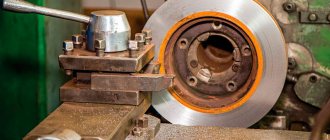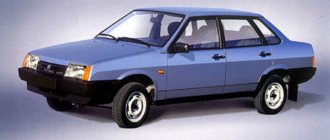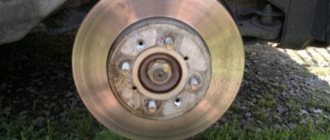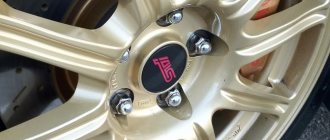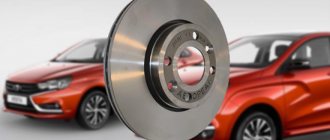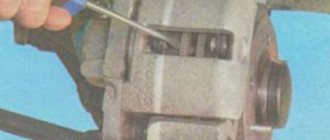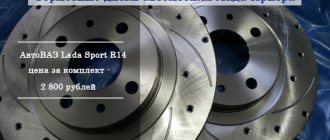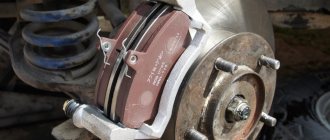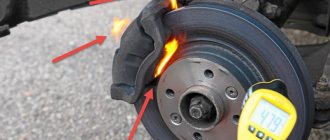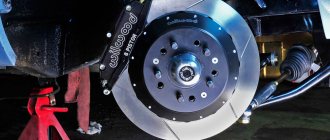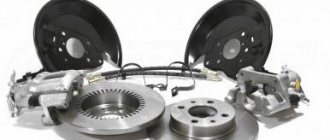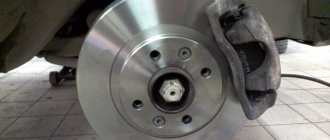26.12.2019
| (Votes: 2, Rating: 3.5) |
Issues discussed in the material:
- Why does the rear wheel get hot due to the brakes?
- How to avoid overheating brakes
- Why does the rear wheel hub get hot?
- What do car owners think about why the rear wheel gets hot?
When the rear wheel (one or both) gets hot, this does not bode well. The simplest reason is significantly exceeding the tire speed limit or driving with the handbrake. In this case, the consequences may be sad - up to the replacement of wheels, but at least the reason will be clear.
However, most often the root of the problem lies not on the surface. The wheel may overheat due to a malfunction of the brake system or problems with the wheel bearing. We will tell you how to find out the real reason and what to do next in our article.
Types of brake discs
There are several types of them. Discs differ in the material they are made of. The element can be made of cast iron, steel, cermet or carbon fiber. The last two types are high cost, and therefore are not used on most production cars.
Metal ceramics and carbon fiber can heat up to 1200-1400 degrees, and this is quite normal for these materials. The coefficient of friction is higher here, but these materials are not so susceptible to thermal deformation. For metal disks, the maximum heating temperature is 500-600 degrees. Overheating will lead to loss of geometric characteristics.
Brake fluid
On older cars, the system was mechanically driven. Over time, manufacturers began to equip cars with more advanced systems. Nowadays hydraulics are used to drive the brakes. The use of such a drive made it possible to reduce the efforts that must be made to reduce speed. At the same time, the braking process itself has become more efficient due to the use of brake fluid.
Automotive service experts recommend changing brake fluid once every two years. Why exactly this period? It's all about hygroscopicity. The fluid absorbs moisture, and the latter destroys parts of the brake system. Due to corrosion, the brake system piston cannot effectively press the pads. Situations often occur when the pistons jam in any one position.
The pad will constantly touch the disc. As a result, the latter will heat up. This is why brake discs get hot after replacing the pads. Old, erased elements did not reach the surface of the disk. And the new ones have a thicker friction lining. Hence the friction.
What is the repair method? The situation can be corrected by regularly replacing the brake fluid. This will avoid corrosion in the lines and system elements.
Handbrake cable - the eternal problem of drums
The rear brake performs not only dynamic braking functions. He also plays the role of a handbrake. Separate cable systems are responsible for this, which tighten the pads and release them when the handbrake is released. In this case, the system does not depend on the brake fluid and is driven mechanically by raising the handbrake lever in the cabin. The cables themselves tend to rust and jam, and they can also move poorly through grooves and holes, creating problems for the car owner.
You can check this as follows:
- select a section of the road where there is a very slight slope, do not turn off the car, release the brake pedal and do not touch the handbrake, record how fast the car rolls;
- then stand in the same place and fully tighten the handbrake, check whether the car is not rolling in this position, it should stand confidently and without the slightest attempt to move down the hill;
- then release the brake pedal, sharply release the handbrake completely and see how the car behaves, in this case you can see how quickly the pads close;
- if the car first stood still and then began to move with a grinding noise, there is a problem in the pad reduction mechanism, which must be repaired for normal driving;
- If the car is left standing still, then the culprit for heating the drum while driving is most likely jammed handbrake cables; they need to be replaced along with all fasteners.
When replacing the handbrake cables, do not forget to change the two working and central cables. The system will be different in each car, but in general the equipment will be similar. Again, you shouldn’t change the cables yourself. This can lead to unpredictable consequences. You can independently repair parts of the braking system if you have sufficient experience and can efficiently assemble the equipment without referring to various reference books and manuals.
Human factor
Every year the weight of cars increases, and the power of the power unit also increases. Car owners put pressure on the accelerator and do not think about how the system functions. But all you need to do is remember the physics course at school. If the resistance increases, the friction force also increases. The same applies to brake discs. To reduce speed on a car weighing 1.5 tons, a lot of compression force must be applied to the pads.
Stopping support
If the brake discs get very hot after replacing the pads, then you should carefully examine this element. The caliper may simply jam. In this case, the pad will not evenly adhere to the surface of the disc. Due to this, the friction coefficient increases. You should also make sure that the caliper guides are well lubricated. If there is no lubricant, it is necessary to treat each guide and the entire caliper mechanism with it. When driving a car with worn brake pads, the system piston may come out of the cylinder higher than normal. The mirror in the place where the piston should be will oxidize or become damaged. Once new pads are installed, the element will not return to its normal position. This problem can be solved by replacing the caliper repair kit. It is also recommended to check the condition of the anthers. If cracks appear in them, they should be replaced. Dust and dirt are one of the reasons for a stuck caliper.
Rules for rolling in new pads
After replacing them at car repair shops, mechanics often forget or simply do not tell clients about the rules for operating a car with new pads. For approximately 200-300 kilometers, it is recommended to avoid emergency and extreme reduction in speed.
During this period, the friction lining rubs against the surface of the disc. Immediately after replacement, braking efficiency decreases. The driver presses the pedal harder. This is the reason why the front brake discs heat up after replacing the pads. But with “grinding in” the problem goes away by itself.
Disk Status
If the disc heats up after replacing the pads, the reasons for this phenomenon may be related to the disc itself. The latter has a shoulder on the working surface. Where does it come from? It was wiped by the old pads, and after installing the new ones, they rub against this shoulder. This is the reason. Repair method: grooving the brake disc. But it is done when the residual thickness of the element is not lower than normal and there are no cracks on the surface.
Why do brake discs get hot?
Heating is not a malfunction if it occurs evenly on both sides and the temperature value does not exceed acceptable limits. In this article, by the word “heat” we mean overheating.
Most discs are made from cast iron. This metal is suitable for daily use - it is inexpensive and has good frictional properties. But it also has its drawbacks: due to frequent braking, the cast iron gets very hot, even to the point of smoke. The pads begin to melt and warp.
To reduce heating, or rather, speed up cooling, discs are produced with voids inside (ventilated). This has almost no effect on the characteristics.
To improve performance, perforations and alloys began to be used. If you replace standard brakes with drilled ones, they will cool down faster.
Why do brake discs get hot? The cause is almost always friction. In 99% of cases. And it doesn’t matter whether the front ones are heated or the rear ones, left or right. Having discovered a problem, car enthusiasts usually check the free play of the wheel:
- remove the car from the handbrake or gear;
- jack up the car;
- spin the wheel.
If you hear a rustling sound or the wheel rotates with force, the problem is most likely in the brake caliper, which does not release the pad (or pads) even when the pedal is released.
Often, rust covers the cylinder bore or the outer walls of the brake piston, which prevents it from moving freely. It can also cover the guides. Restoring a caliper at a service station is called development. It is necessary to change the rubber seals - this can only be done if you have a repair kit. Sometimes you have to change the piston too.
Another reason why the wheel rotates slowly and the brakes heat up is wear of the wheel bearing (when the brake disc heats up on one side). Actively heating up, it transfers heat to the disc brakes. True, in this case the movement will be accompanied by a howl or hum at certain speeds.
Well, what if the wheel rotates freely in a suspended state, but after the ride it burns your fingers badly? This can happen for a number of reasons:
- Severe wear or deformation of discs. As their thickness decreases, heating occurs faster.
- Installation of new low-quality pads.
- Replacement of brake fluid with inappropriate one.
- Large production of pads.
- The front brake discs heat up on cars with rear drum brakes - because the front axle bears a large load when braking.
- Excessively aggressive driving. With constant acceleration and sudden stops, the brakes do not have time to cool down.
- Delamination of the inner surface of the brake hose. This is an obstacle to the circulation of brake fluid - the pads will not be able to diverge normally.
- Air in the brake system circuit.
Front brake discs
- wear;
- wedging caliper;
- low quality pads;
- aggressive driving with rear drum brakes;
- The pads were installed incorrectly.
Hello, dear car enthusiasts! Once again we return to the eternal topic of car safety while driving - the topic of brakes. A common question from novice car enthusiasts is why brake discs get hot.
Overheating of brake discs is a pressing problem during the operation of the braking system, on which your life and health directly depend. After all, a modern car, even a serial one, is a fairly powerful device that develops considerable speed. Accordingly, its timely stopping by braking helps to avoid many dangerous situations on the road.
What is the normal temperature when the brake disc is operating?
For the manufacture of brake discs for mass-produced cars, steel and alloy cast iron are used. We exclude consideration of ceramic brake discs; this product is more likely for cars with specific tasks.
How to avoid overheating brakes
Remember to take your foot off the brake. You should not press the pedal for a long time: when driving on city roads, such actions lead to rapid wear of the pads and discs. On the highway, during a long descent, this will cause the entire brake system to overheat. Pressing the brake pedal once at speed is much better than decelerating repeatedly.
Brake fluid . If you purchased a used car, be sure to change the brake fluid. Since you cannot know for sure when the previous owner did it.
Brake fluid absorbs moisture, so it gradually loses its properties. Perhaps the previous owner's brakes were already overheating. If so, then air bubbles could definitely appear inside, which would negatively affect the performance of the braking system.
Pads from an unverified manufacturer . Pads from a company that is not well known, but purchased by you at several times cheaper - this is a purchase that can become a time bomb. The brakes work worse, and such pads do not remove heat from the discs well. Many may say that heat dissipation is not the main function, but good manufacturers take this fact into account when selecting materials.
When purchasing a part from an unreliable company, there is a possibility that the linings themselves will fly off.
The shape of the rims is important! It is worth paying attention to the fact that the level of ventilation of the brake system is directly dependent on the shape of the wheel rims. Dust shields also have a negative effect on cooling, however, there is no need to remove them, since there is a reason for their presence.
Use engine braking more often . This advice also applies to owners of cars with manual transmission. Contrary to popular belief, nothing bad will happen to your engine, and the load on the brakes will be significantly reduced.
We recommend
“Winter tires for Nissan: review of models and selection criteria” More details
Summary . Based on the above, in order to avoid overheating of the brake system, it is extremely important to monitor the condition of the brake fluid and learn how to brake with the engine.
Why does the rear wheel hub get hot?
If the rear left wheel or hub gets hot, there are many reasons and, accordingly, there are also ways out of the situation. Often, overheating of the hub is accompanied by the car’s inability to hold the road, and the car will be “pulled to the side.”
Perhaps it's because the excess heat could be coming from a wheel bearing or a faulty brake system. We have already talked in detail about the braking system above; here are the signs of bearing problems.
What does a problematic bearing indicate:
- when the wheels overheat, the heating of the brake caliper will hardly be felt;
- a worn bearing will hum or howl;
- It is often advised to check whether the wheels have play on the hub - it will only appear if the bearing is heavily worn.
The cause may be an overtightened bearing (if the wheel bearing has recently been repaired/replaced). In addition, check that the play of the rear wheel is precisely at the hub; it can often be confused with play, for example, of a ball joint.
Organize the lifting of the problematic rear wheel on a jack or lift, and rotate it. It should spin evenly and without additional effort. Remove the brake caliper, install it back, try turning it again, this is how you will accurately determine the culprit. If the torsion pattern remains unchanged, then the problem is in the bearing. Keep in mind that overheating of the rear hub is also possible due to jamming of the parking brake pads. In many cars they are located inside the brake disc and can also “stick”.
If the problem is with the wheel bearing, either front or rear, the repair will be a little more complicated and require more tools. We will divide the work by causes and methods of troubleshooting.
The bearing is very tight. The problem can most often be encountered after a recent repair. She talks about a specialist mistake. If the rear wheel turns with difficulty or sticks, you can solve the problem by loosening the hub nut and re-tightening it with the least amount of force. Be careful: some automakers may make wheel nuts with left-hand threads.
If you observe increased play in the rear wheel, the problem is that the bearing is not tightly tightened. A poorly tightened rear hub after recent repair work is again a mechanic's mistake. But if no repairs have been made to the car, and the block gets hot, it means the bearing is badly worn. In this case, you will have to replace the wheel bearing or the entire hub (depending on the design of your car). If it is not possible to immediately resort to a full repair, try tightening the bearing, reducing the gap in it to a standard size. This method cannot be called a repair. Such actions will make it possible to temporarily postpone repair work. Having resorted to this measure, be sure to disassemble the bearing to remove the old lubricant (there are many particles in it that separate as the metal wears out), and generously distribute the new lubricant.
There is no lubricant or it has lost its properties. It is important to lubricate the bearing well; the fresh compound must be evenly distributed in the required quantity. Only the new lubricant will be free of debris, moisture and signs of wear. A problem of this nature is usually observed when a special seal in the form of a ring (oil seal) breaks through, ensuring the tightness of the hub. If the seal is torn, the lubricant is very quickly washed out, gathers dust and undergoes oxidation. You can replace the oil seal and lubricant and thereby solve the problem with the bearing. However, by the time you discover the cause, without the right amount of lubrication, the bearing elements will have worn out enough that they will have to be completely replaced.
When tightening the hub bearing, you need to first tighten the rear wheel, only then gradually loosen the tightening until the rotation of the latter becomes easy and uniform. Another tip: check the tightness of the hub nut after driving 300–500 km in order to make a second adjustment if necessary.
All of the above recommendations regarding the fact that the front or rear wheel hub is heating up are generalized. To carry out repair work correctly, it is important to familiarize yourself with the technical characteristics and recommendations for repairing your particular machine. Do not forget that a press may be needed to remove and install a new bearing; we do not recommend driving in or knocking out bearings.
